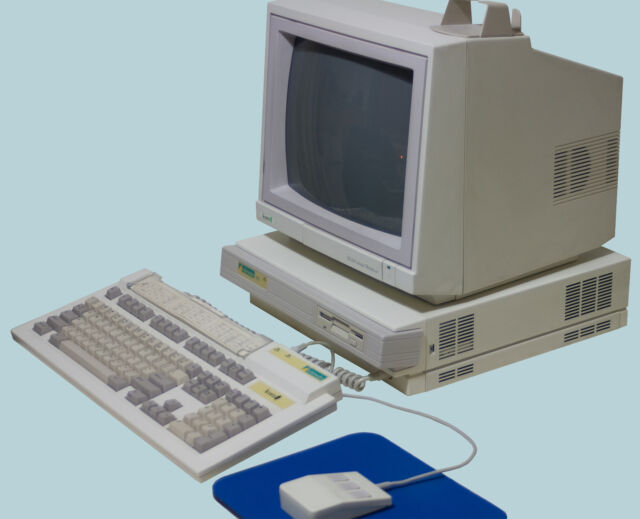ARMing a new computer
So Acorn had this amazing piece of technology, years ahead of its competitors. Surely financial success was soon to follow, right? Well, if you follow computer history, you can probably guess the answer.
By 1985, sales of the BBC Micro were starting to dry up, squeezed by cheap Sinclair Spectrums on one side and IBM PC clones on the other. Acorn sold a controlling interest in its company to Olivetti, with whom it had previously partnered to make a printer for the BBC Micro. In general, if you’re selling your computer firm to a typewriter company, that’s not a good sign.
Acorn sold a development board with the ARM chip to researchers and hobbyists, but it was limited to the market of existing BBC Micro owners. What the company needed was a brand new computer to really showcase the power of this new CPU.
Before it could do this, it needed to upgrade the original ARM just a bit. The ARM V2 came out in 1986 and added support for coprocessors (such as a floating point coprocessor, which was a popular add-on for computers back then) and built-in hardware multiplication circuits. It was fabricated on a 2 micrometer process, which meant that Acorn could boost the clock rate to 8 MHz without consuming any more power.
But a CPU alone wasn’t enough to build a complete computer. So the team built a graphics controller chip, an input/output controller, and a memory controller. By 1987, all four chips, including the ARM V2, were ready, along with a prototype computer to put them in. To reflect its advanced thinking capabilities, the company named it the Acorn Archimedes.

Given that it was 1987, personal computers were now expected to come equipped with more than just a prompt to type in BASIC instructions. Users demanded pretty graphical user interfaces like those on the Amiga, the Atari ST, and the Macintosh.
Acorn had set up a remote software development team in Palo Alto, California, home of Xerox PARC, to design a next-generation operating system for the Archimedes. It was called ARX, and it promised preemptive multitasking and multiple user support. ARX was slow, but the bigger problem was that it was late. Very late.
The Acorn Archimedes was getting ready to ship, and the company didn’t have an operating system to run on it. This was a crisis situation. So Acorn management went to talk to Paul Fellows, the head of the Acornsoft team who had written a bunch of languages for the BBC Micro. They asked him, “Can you and your team write and ship an operating system for the Archimedes in five months?”
According to Fellows, “I was the fool who said yes, we can do it.”
Five months is not a lot of time to make an operating system from scratch. The quick-and-dirty OS was called “Project Arthur,” possibly after the famous British computer scientist Arthur Norman, but also possibly a shortening of “ARm by THURsday!” It started as an extension of BBC BASIC. Richard Manby wrote a program called “Arthur Desktop” in BASIC, merely as a demonstration of what you could do with the window manager the team had developed. But they were out of time, so the demo was burned into the read-only memory (ROM) of the first batch of computers.
reader comments
328